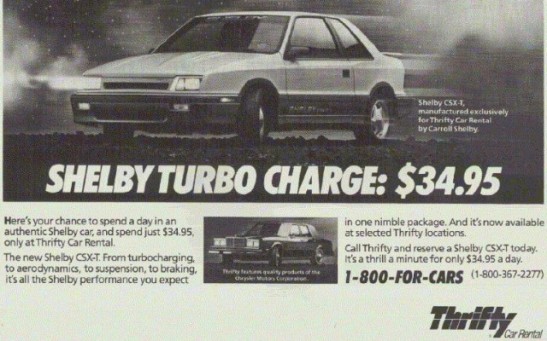1987-1989 Shelby CSX: More Than Meets the Eye

1989 Shelby CSX
For much of my young adult life, I had come to think of Chrysler as doomed to occupy third wheel in the American Big Three hierarchy. Maybe for that reason I always admired it’s attempts at luxury or performance on a budget. Cars like the Dodge Omni GLH were smoking BMWs in the mid-‘80s. Since then, in addition to ever improving it’s own scrappy performance cars, Chrysler rolled out higher-performance models with the help of Shelby Enterprises. During the ’80s, Shelby was on a roll for Chrysler. In addition to behind the scenes tuning of regular production Dodges, Shelby created some special versions of the the Lancer and Omni GLHS that overlapped the CSX towards the end of their production cycles. It seemed that as one car went, another arrived to take its place.
The CSX was based on the lowly Dodge Shadow. Normally, it along with the Plymouth Sundance twin was one of the cheapest new American cars you could buy at just under $7,500. The 97 hp standard models were adequate transportation for thousands of first time buyers and seemed to be everywhere. It’s tidy 97 inch K-Car derived wheelbase offered just the right packaging to be small but not import dainty. The Shadow’s biggest parlor trick might have been its stealthy hatchback design that appeared like a standard coupe (giving onlookers the illusion buyers spent more for a proper coupe). Optioned right, a Shadow could be cute if not ubiquitous. Chrysler offered more performance with the respectable Shadow ES with as much as 146 hp from a mildly boosted 2.2 liter turbocharged engine.

1987 Shelby CSX
For those who wanted more from the humble Shadow, there was always the Shelby CSX. Identifiable by its ground effects, spoiler and special grille, the CSX appeared aggressive, but not over the top (rare for a low cost performance car of the time). In fact it was easy to confuse it for later ES models, a mistake at a stop light drag race. The smaller dimensions of the Shadow had the potential to make the CSX look cartoonish in full dress up gear, but larger tasteful wheels and a two-tone color scheme on some cars made it appear longer than it was. In the three model years that the CSX was available, they came in only three colors: black (’87), white (’88) and Red with gold ’15 rims (’89). There was a 150 hp version (without an inter-cooler) called the CSX-T that was available as a Thrifty rental exclusive.

1988 Thrifty ad
The CSX’s claim to fame was it’s 175 hp 2.2-liter turbocharged engine. The SOHC design was created by Chrysler with turbocharging in mind. So when Shelby added one with 12-psi boost, the engine and 5 speed manual transmission was ready for it. Other tweaks included extensive suspension changes and quicker ratios to the rack-and-pinion steering. In fact, many automotive journalists agreed that the CSX’s chassis tuning begged for more power (and grip), despite being front heavy and having a beam axle rear suspension. With curb weight around the 2,600 pound mark, the CSX had no trouble spinning its front wheels to 60 mph in under 7 seconds, even with turbo lag.
Aside from Shelby stamped everywhere, the CSX interior was not too much different than a well equipped ES. The blocky ‘80s style dash looked like any other Shadow, but had gauges and controls where there had been empty boxes on other models. A three spoke steering wheel, special seats and a turbo boost gauge were the biggest cues to the CSXs performance from inside.

1988 Shelby CSX interior
1989 marked the year of the final CSX, now called CSX-VNT. The VNT stood for variable-nozzle turbo, a new technology from Garrett, the first of its kind in a production car. Now in a new 2.2 Turbo IV engine, power remained the same, but there was considerably more torque at lower RPMs. What’s truly amazing was that Car & Driver magazine reportedly got a 1989 Shelby CSX-VNT up to 156 mph! There were only 500 examples of the 1989 model built.
The CSX gave Chrysler/Dodge some performance credibility in the marketplace, even if the public at large was indifferent as they continued to buy larger Mustangs and Camaros in droves. It was easy to see why, the CSX had a 80% markup over the regular ES. At nearly $14,000 in 1987, it’s price was more in line with the similarly priced (and larger) Mustang LX and Camaro RS. For that reason, production numbers were kept low to maintain exclusivity. As an import competitor, the CSX had as much technology as many Japanese competitors. The only difference being that it lacked a fully independent suspension and DOHC technology like Toyota’s Celica or Honda’s Civic Si. Being that it was essentially a Chrysler product, it also lacked the reputation for quality in the minds of young Gen X buyers who were stepping out to buy their first car.
The CSX cars were gone by the ‘90s, but the basic look and turbocharged engines continued in the regular Shadow ES. The Shadow itself underwent a subtle redesign for the 1990 model year. By then, enough of the CSXs DNA had rubbed off onto the ES models that a Shelby seemed no longer necessary. Shelby had moved on to other projects leaving the Shadow with a real performance heritage.

1989 Shelby CSX
